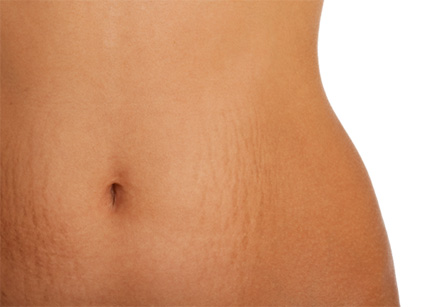Stretch Marks
Introduction
Stretch marks or striae are considered as scars which occur due to sudden stretching of skin as a result of sudden changes in body size, such as during pregnancy, puberty, or rapid weight-gain. Most of the pregnant women usually get stretch marks around their abdomen, hips and thighs. Other conditions such a cushing’s syndrome, Ehlers danlos syndrome and overuse of cortisone skin creams can cause striae. Genetic factors play a vital role in having stretch marks. If the mother had stretch marks, there are high chances that daughter will also get it.
Stretch marks occur in the dermis, the elastic middle layer of skin that allows it to retain its shape. When constantly stretched, the dermis can break down leaving behind stretch marks.
The woman undergoing treatment of stretch marks should not expect perfection, as all these methods can sometimes fail to eliminate the marks completely.
There are various techniques and remedies developed to prevent as well as to reduce the appearance of both new and old marks. It is best to treat the stretch marks as soon as they are found. The stretch marks readily respond to treatment in early stages of development, when they are still red or purple. However, once they pass the initial stages and become silvery white, with deep indentations on surface, they are difficult to treat.
Stretch marks are the result of the skin suddenly stretching. The middle layer of skin (dermis) breaks in places, allowing the deeper layers to show through

Stretch marks do not look the same on every person. The appearance of stretch marks depends on the color of skin, their distribution and severity. They usually start as pink, reddish brown, brown, or dark brown marks, and fade over time to a more silvery color.
Common sites of stretch marks are:
1. Abdominal area
2. Thighs
3. Hips
4. Breasts
5. Upper arms
6. Lower back
Treatment of stretch marks:
Some modalities of treatment of stretch marks are described here. But efficacy of some of them is yet to be proven.
1. Moisturizers. Use of moisturizers three to four times a day makes the skin more pliant, flexible, and better able to stretch in hydrated state. Products containing cocoa butter or shea butter should be massaged deep into breasts, belly, hips, and buttocks.
2. Wheat germ oil: There is not much scientific data on whether home remedies for stretch marks, such as wheat germ oil, can help. But it may be helpful in early phases.
3. Glycolic acid: it is an alpha hydroxy acid which works on stretch marks by increasing collagen production. Glycolic acid can also be administered in higher doses by a dermatologist.
4. Vitamin C products: vitamin C formulations also increase collagen production and help in early-stage stretch marks. For maximum effect, combine with glycolic acid.
5. Peptide-containing products. Peptide-containing products are widely marketed as creams and, but there is no convincing data that these work.
6. Retinoids. Retinoidsare considered as fairly effective in increasing collagen and elastin production during the early stages. They should be avoided if the patient is pregnant or nursing. Retinol, tretinoin, and the prescription medications are available formulations of retinoids. They can be used in conjunction with glycolic acid for better results.
7. Laser treatment: This popular treatment option is used by dermatologists for treating stretch marks. Lasers promote synthesis of healthy, new collagen, which has been damaged when stretch marks appear. Vascular lasers targets swollen and inflamed blood vessels and are used for red and purple stretch marks. They increase skin cell production and collagen production. For treating more old and indented stretch marks, the fractionated laser is used, which hits the tiny fractions of the skin. It works usually in a grid-like pattern.
8. Dermabrasion- it is the method of abrading the skin surface by tiny electrical brushes. It can treat early as well as old stretch marks.
Results:
The woman undergoing treatment of stretch marks should not expect perfection, as all these methods can sometimes fail to eliminate the marks completely. However, stretch marks should not be considered as permanent or that they cannot be treated.
Significant improvement tends to occur and almost all the people are satisfied as well as more confident after undergoing some modality of treatment.